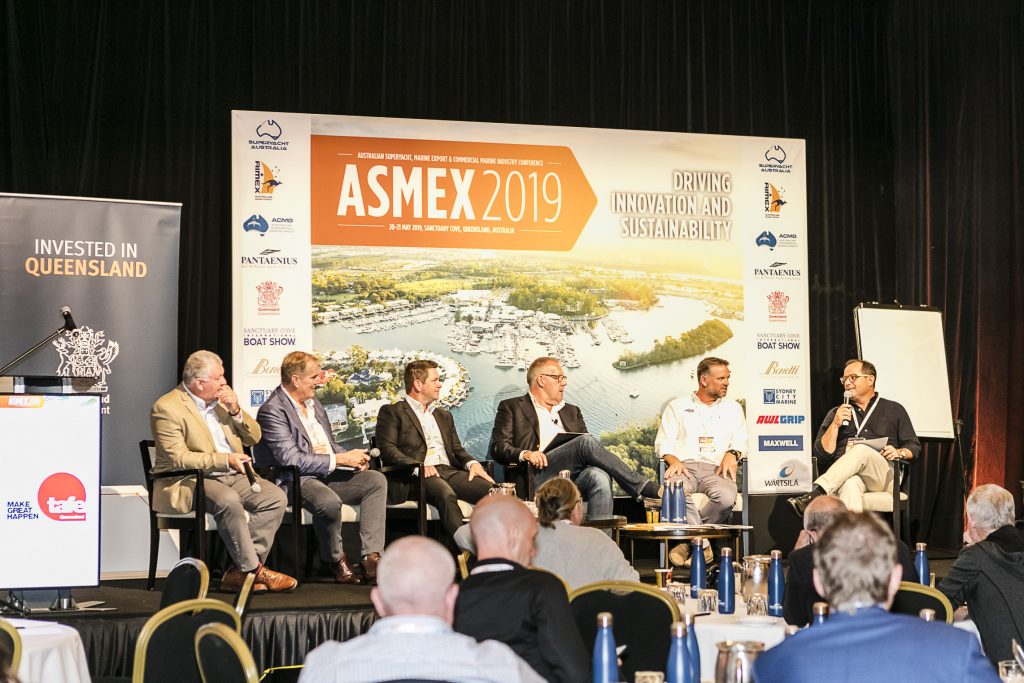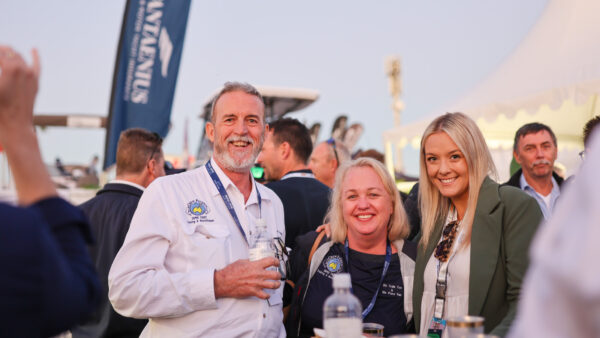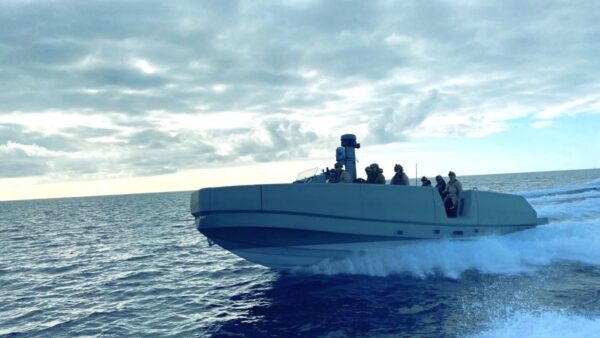COLLABORATION & EDUCATION THE THEMES OF ASMEX 2019 DAY 1
A full house of 170 delegates from around the region and the globe, and an atmosphere of energy and expectation kicked off the 9th annual Australian Superyacht Marine Export & Commercial Marine Industry Conference (ASMEX), Monday 20 May at the InterContinental Sanctuary Cove.
The Gold Coast delivered a downpour, but spirits were not dampened and after a buffet lunch, the conference commenced with an official welcome from Richard Chapman, AIMEX President, Barry Jenkins, Chair of Superyacht Australia and Jeremy Spear, Chair of Australian Commercial Marine Group.
The theme of AMEX 2019 is “Driving Innovation & Sustainability”, with the aims of sharing ideas, strengthening the Australian identity through collaboration, as well as recognising and promoting Australian ingenuity and diverse capabilities to allow us to compete globally.
Richard Chapman mentioned the value of nurturing Pacific and North Asian alliances and coordinating regional activities, particularly in the lead up to the major events of 2019-21, including the Rugby World Cup in Japan, Tokyo Olympics and the America’s Cup in Auckland.
AIMEX-Superyacht Australia and ACMG members, he said, would be flying the flag at events in Tahiti, Fiji, Monaco and at METS Amsterdam. “It’s amazing what unity and entrepreneurial energy can achieve.”
MC, Martin Redmayne, Editor in Chief of The Superyacht Group, introduced the first speaker, Michael Healy, MP for Cairns and Queensland Government Superyacht Strategy Champion, who began by putting the onus back on industry to tell government what is required for growth.
“It’s your industry, and we at the state and federal level need your input. The Premier and Minister understand the huge potential of the superyacht and marine industries. You need to treat Ministers like clients – articulate your issues and some solutions in a concise document, and be collaborative about getting your message to government through your industry groups and organisations.
“When government and industry work together in partnership, we can create jobs and achieve billions in revenue.”
Martin Redmayne and AIMEX CEO, David Good followed with their assessments of the state of the global and local markets: stats and facts on new builds, fleet growth, the most prolific builders, trends in refit, the world’s leading yards, superyacht movement in the Asia-Pacific, insight into Captains’ and Owners’ priorities and the economic value of visiting superyachts, including crew spend.
David Good highlighted the fact that in 2018, 76 foreign flagged vessels visited our shores, including the largest at 126m and 12 vessels above 60m.
“There are 120 superyachts in our region. We can do better,” he advised, referring to the predicted benefits to amending the Coastal Trading Act and current legislation pertaining to the importation of foreign vessels, which deters them from chartering in Australian waters.
“We need a simple solution that allows them to charter,” he continued. “Why? Because half the world’s fleet are charter yachts.”
He then cited the Fiji experience. “Vessels visiting Fiji stayed an average of 21 days prior to the change in their charter rules. Post charter rule changes, they averaged 136 days.
“They are more likely to stay for the whole season. Fortunately for us, Australia is not seasonal. We have the full year potential. When you consider superyachts spend 10 to 12 percent of their value on operational costs and maintenance, that’s a lot in revenue to industry and the economy.”
The benefits include jobs, export dollars, investment in infrastructure, word of mouth marketing, increased employment and retention.
AIMEX-Superyacht Australia will continue to work hard to lobby government, emphasising the potential value to the economy in the lead up to the major events in our region, and promoting the Pacific (Tahiti, Samoa, Cook Islands, Australia and NZ) at yacht shows and trade events in Europe and the US.
Close to the hearts of Australians and it turns out, millions of concerned world citizens, the Great Barrier Reef was the subject of Andrew Ridley’s presentation. CEO of Citizens of the GBR, Andrew was also founder of the Earth Hour initiative, which started in 2002 in Australia and became a global phenomenon thanks to “learning to organise on a massive level with few resources”.
Inspired by the perception in Europe that “the Reef is dead” following two sequential bleaching episodes which made the news where he was living in the Netherlands, Andrew was motivated to understand the issues for himself, and then engage the world to comprehend and protect the GBR.
Working with over 100 conservation projects, organisations such as AIMS, GBRMPA, University of Queensland and James Cook University, tourism operators and increasingly superyachts, Citizens of the Reef is conducting pilot census, to test methodology ahead of a full survey scheduled for 2020.
Tasmania was the Region in Focus, and industry proponents, Roger Janes from Richardson Devine Marine Constructions, Robert Miley from the Tasmania Maritime Network and Jeremy Spear, Spear Green Design, outlined the challenges and innovative solutions Tassie builders and shipyards face, as well as the myriad attractions that make the state a fascinating cruising ground for superyachts.
Chris Blackwell, Sales & Marketing Manager of Echo Yachts presented highlights of the WA marine industry, covering Austal, Silver Yachts, AMC and Echo.
Robust debate characterised the panel session on the topic of “Growth drivers in the Australian refit and repair market”, led by Steven Fisher of Rivergate, Brenton Fischer Sydney City Marine, Trenton Gay Gold Coast City Marina and Shipyard, Justin Parer BSE Maritime Solutions and Mark Phelps The Yard Brisbane.
It was agreed that Australian yards have world’s best standards, and that government at all levels was required to “get onboard” to facilitate growth, but while most agreed that major investment in new facilities and equipment is a positive for the industry and that skills shortage was a serious concern, opinion was divided on the rate of the predicted influx of superyachts.
Steven Fisher, Director of International Business at Rivergate Marina & Shipyard cautioned that yards needed to “tread carefully to avoid oversupply”.
“I agree that the market is forcing investment, but too much capability could have a negative impact,” he said, shifting the focus from expansion to a shortage of infrastructure in the water. “Put simply, we need more berths at more marinas.”
Trenton Gay, CEO at GCCM was more buoyant in his outlook, gained from first-hand experience in the region and at US shows. He stated “Boats want to come here and they prefer to stay here. The exchange rate is favourable, we have the skill set and attitude, the climate, English speaking and similar laws.
“It’s a great environment,” he continued. “Boat Captains and Owners want to come here for sightseeing, cruising and the quality work.”
Mark Phelps said the industry needed to join together to “sell the South Pacific in the US, Europe and Asia”.
“We need to reach the global fleet to tell them they’re well and truly covered in Australia.”
Brenton Fischer, Director at Sydney City Marine compared his CBD facility to those of Queensland and others in NSW, acknowledging that “space is at a premium and we won’t compete on price”.
“Certainly, I believe NSW is not as proactive as we could be. At SCM, we have a 25,000m² hardstand, which sounds like a lot, but when we have commercial, government and recreational vessels from all over Sydney Harbour and NSW, it fills up quickly.
“In terms of strengths, compliance in safety and environment, location and convenience are our fortes.”
The West Coast of America and Canada were identified as significant markets for cruising superyachts. Craig Norris, a Day 2 Speaker, advised Superyacht Canada would be making more of an impression on the global stage and said “As the Pacific, we have to get together”, heralding the concept of a Pacific Superyacht conference.
The final panel discussion for Day 1 was fully focused on Asia: sales of new vessels, the second-hand market, cruising, chartering, customisation, infrastructure and a unique insight to cultural factors influencing the market.
Carmen Lau-Stratton, MD of Camper & Nicholsons Asia informed delegates that in terms of cruising habits “the Asian market is hard to pin down”.
“Owners make their own decisions, but they rely on yacht managers to do their research.” She urged the Australian industry to provide more detailed information on “distances, costs, stopovers, what to do in each place, and for service clear pricing structure”.
“Hong Kong is the superyacht hub of Asia, with 100+ vessels over 30m. We are here to find out the options so that we can give our owners the choice. Give us guidelines so we can advise our clients.”
Peter Mahony, GM at Benetti Asia concurred. “I want my boats looked after very well, so I recommend they come to Australia for servicing.”
Andy Shorten, MD at The Lighthouse Consultancy, based in Indonesia, reported that Asia is still seen as “a risk” for European and US-based Captains. “Then once they’re here, they realise it’s a lot easier to do a lot of things than many other places. We provide them the greatest possible support, which includes constant communication and local knowledge, because we don’t want to leave anything to chance. Then one they’ve done their cruising, they talk about going home for maintenance and servicing.
“Australian infrastructure is so impressive, you need to promote yourselves more in Asia.”
Zara Tremlett, Writer & Researcher covering SE Asia and Australia for Superyacht Services Guide, agreed. “Of all the hundreds of yachts that visit Thailand, Myanmar, Malaysia and Singapore, very few travel to Australia. They need access to a more detailed plan for cruising and work to give owners and Captains the confidence to come to Australia.”
After an absorbing succession of presentations and panels, Day 1 wrapped up with Welcome Drinks, sponsored by Sydney City Marine, which was the chance for delegates to mingle, discuss the day’s proceedings and share their own experiences.
“Feedback so far is all positive,” said David Good, CEO of AIMEX. “People are impressed with the calibre of speakers and the clarity of their message to all segments of the Australian industry – we are seeking your expertise and want to know more.”
Day 2 begins at 9am Tuesday 21 with a presentation on the forecast yachting boon from the 36th America’s Cup in Auckland in 2021, along with the Rugby World Cup and Tokyo Olympics, followed by several break-out sessions.



